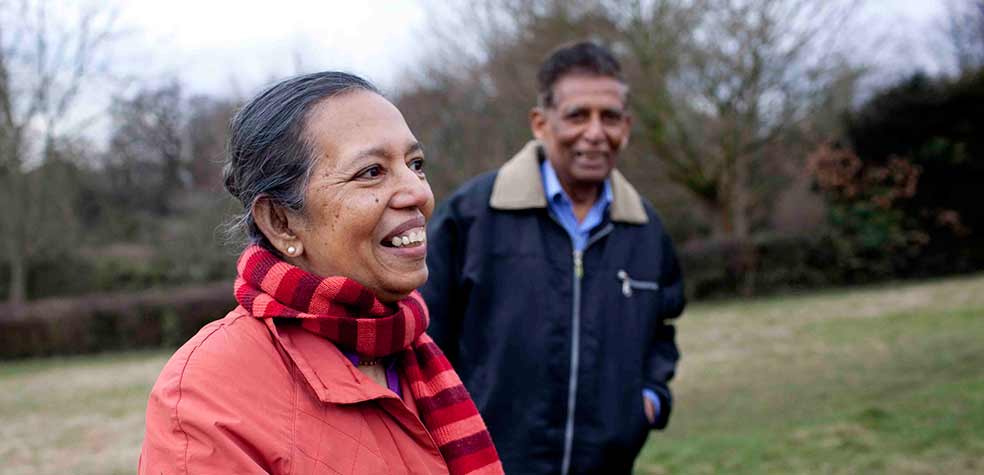One step at a time

We all know that physical activity is good for us. But as we get older, staying active is even more important.
Working with Sport England and the Richmond Group of charities, Age UK has explored how best to help people become more active in later life.
Why activity matters
Many older people are 'physically inactive' according to the Government definition, which means they do less than 30 minutes per week of moderate intensity activity.
As we get older, our activity levels often decrease. That may be due to a long-term health condition, or practical, financial or emotional reasons – for example, not being able to get to an exercise class or worrying about falling.
However, with the normal ageing process causing loss of muscle mass and bone density, which affects strength, balance and posture, it's one of the most important times in life to try to keep moving.

Encouraging inactive older people to take up some physical activity is an urgent and important issue. It could not only enhance wellbeing and enjoyment of life, but also reduce the risk of illness for older people, and save money for public services such as the NHS.
Information about being more active
We can help you get moving more so you'll feel better for longer. If you're living with a long-term condition, the We Are Undefeatable campaign has ideas and inspiration.
Our research
We undertook a qualitative research project to understand the experiences, attitudes and opinions of inactive older people so we could improve how we support them to be more physically active. This involved interviewing over 80 inactive older people in four locations across England.
We found that the older people we spoke to tended to fall into four groups, based on how healthy they were and how much they enjoyed being active:
- Capable and motivated: people who enjoy physical activity and are in good health.
- Capable but not motivated: people who don't enjoy physical activity but are in good health.
- Not as capable but motivated: people who enjoy physical activity but have health problems.
- Not as capable and not motivated: people who don't enjoy physical activity and have health problems.
How do older people respond to different messages about activity?
Health benefits alone aren't enough
Generally, the inactive older people in our project accepted that doing more exercise would probably be better for their health, but good health by itself was not enough for them to take up or maintain lifestyle changes.
"I know all the theories about exercise. Rationally I know I should be doing more exercise, but other things override that."
Some older men find medical advice hard to swallow
We also found that men – particularly those from lower socioeconomic groups – were more likely to be cynical or defensive about medical advice and guidelines.
"It’s almost a fear approach. It can be effective with certain groups of people, but for others it would be a complete turn off."
Independence is motivating, symptom management less so
Messaging about the link between physical activity, mobility and independence was more helpful and seen to be more credible than links to disease prevention or symptom management.
"It can't lessen aches and pains, can it really?"
It's common to worry about making things worse
People living with health problems were anxious about exercise making their condition worse, or increasing risk of injury.
"I worry that I'll fall over – it's happened so many times."
Marketing needs to be nuanced
While most people we spoke to didn't like to think of themselves as 'old' so didn't respond well to the idea of 'classes for older people', many were nervous of joining in universal exercise or activity programmes in case they feel embarrassed or the activity is inappropriate.
"I get on well with young people but I would just feel more comfortable with people being able to do the same things as I’m doing."
Lighter activities feel more achievable
Inactive older people would consider doing more gentle activities – like yoga, swimming, and bowls – but not vigorous ones, which were seen as unsuitable and a health risk in older age.
"I like walking. We take the grandson out and walk round the park and walk around the lake. You do feel better, but that's probably the only exercise we do."
Activity needs to be fun!
There was a strong preference for combining physical activities with socialising and other interesting, fun or enjoyable things, like playing with grandchildren. This worked especially well for people who didn't like the idea of being active.
"I'd definitely do it with other people. I think it's more interesting. You'd have more of a laugh."
Top tips for encouraging people to be more active in later life
- Understand how they feel about activity.
- Make being active fun and social.
- Take small steps to start with.
- Talk about the link to staying independent.
- Tailor activities to match people's abilities and conditions.
Find out more
Read our full research report, One Step at a Time, and download the Activity Alliance's Talk to Me Principles, which give tips and ideas on how to engage older people in physical activity.
If you have any queries, or for further information, please contact us.
With thanks to National Lottery funding from Sport England to support this research, and our highly valued collaborative partners in the Richmond Group of charities.
